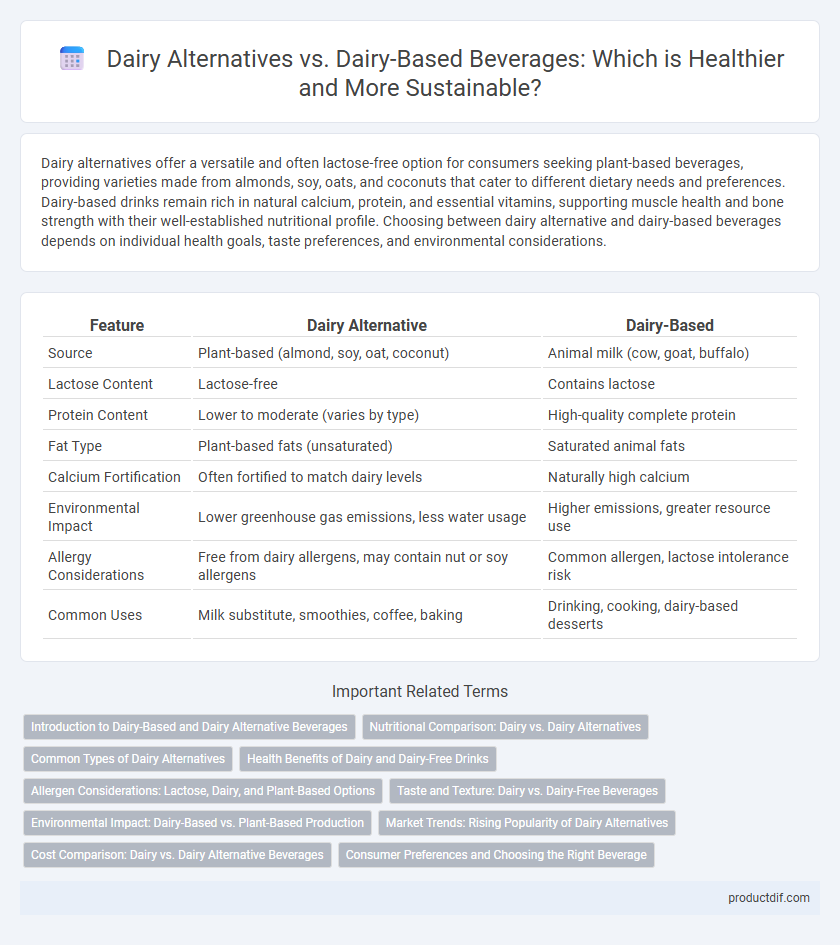Dairy alternatives offer a versatile and often lactose-free option for consumers seeking plant-based beverages, providing varieties made from almonds, soy, oats, and coconuts that cater to different dietary needs and preferences. Dairy-based drinks remain rich in natural calcium, protein, and essential vitamins, supporting muscle health and bone strength with their well-established nutritional profile. Choosing between dairy alternative and dairy-based beverages depends on individual health goals, taste preferences, and environmental considerations.
Table of Comparison
| Feature | Dairy Alternative | Dairy-Based |
|---|---|---|
| Source | Plant-based (almond, soy, oat, coconut) | Animal milk (cow, goat, buffalo) |
| Lactose Content | Lactose-free | Contains lactose |
| Protein Content | Lower to moderate (varies by type) | High-quality complete protein |
| Fat Type | Plant-based fats (unsaturated) | Saturated animal fats |
| Calcium Fortification | Often fortified to match dairy levels | Naturally high calcium |
| Environmental Impact | Lower greenhouse gas emissions, less water usage | Higher emissions, greater resource use |
| Allergy Considerations | Free from dairy allergens, may contain nut or soy allergens | Common allergen, lactose intolerance risk |
| Common Uses | Milk substitute, smoothies, coffee, baking | Drinking, cooking, dairy-based desserts |
Introduction to Dairy-Based and Dairy Alternative Beverages
Dairy-based beverages, derived from cow's milk, are rich in calcium, protein, and essential vitamins, playing a significant role in traditional diets worldwide. Dairy alternatives, including almond, soy, oat, and coconut milk, offer lactose-free and plant-based options suitable for vegans and individuals with lactose intolerance. Innovations in dairy alternatives continue to improve nutritional profiles and flavor profiles, making them increasingly popular in health-conscious and environmentally aware consumer segments.
Nutritional Comparison: Dairy vs. Dairy Alternatives
Dairy-based beverages typically provide higher amounts of protein, calcium, and vitamin B12 compared to many dairy alternatives like almond or rice milk, which often have lower natural nutrient content but may be fortified. Plant-based options such as soy milk and oat milk offer comparable protein levels and contain beneficial fiber and antioxidants absent in traditional dairy. Consumers seeking enhanced nutrient profiles should check labels for fortification to ensure intake of essential vitamins and minerals.
Common Types of Dairy Alternatives
Common types of dairy alternatives include almond milk, soy milk, oat milk, and coconut milk, each offering unique nutritional profiles and flavors. Plant-based beverages often provide lactose-free, lower-calorie options compared to traditional dairy milk. Fortification with vitamins such as D and calcium enhances their nutritional value, making them popular choices for consumers with lactose intolerance or dietary restrictions.
Health Benefits of Dairy and Dairy-Free Drinks
Dairy-based beverages provide essential nutrients such as calcium, vitamin D, and protein, which support bone health, muscle function, and overall growth. Dairy alternatives like almond, soy, and oat milk offer lactose-free options rich in vitamins and antioxidants, beneficial for those with lactose intolerance or dietary restrictions. Choosing between dairy and dairy-free drinks depends on individual health needs, with dairy delivering complete proteins and dairy-free options often lower in calories and cholesterol.
Allergen Considerations: Lactose, Dairy, and Plant-Based Options
Lactose intolerance affects approximately 65% of the global population, making plant-based dairy alternatives like almond, oat, and soy milk essential for reducing allergen exposure. Dairy-based beverages contain lactose and milk proteins such as casein and whey, which are common allergens triggering reactions in sensitive individuals. Selecting dairy alternatives not only caters to lactose intolerance but also addresses milk protein allergies, offering a diverse range of hypoallergenic beverage options.
Taste and Texture: Dairy vs. Dairy-Free Beverages
Dairy-based beverages typically offer a rich, creamy texture and a naturally sweet, smooth taste due to lactose and milk fats. Dairy alternatives such as almond, oat, or soy milk often vary in mouthfeel, with some providing a thinner consistency and a nuttier or more plant-forward flavor profile. Brands increasingly enhance dairy-free options by adding stabilizers and sweeteners to mimic the texture and taste of traditional dairy, improving consumer acceptance.
Environmental Impact: Dairy-Based vs. Plant-Based Production
Dairy-based beverage production generates significantly higher greenhouse gas emissions and requires more water and land resources compared to plant-based alternatives like almond, soy, or oat milk. Plant-based options typically have a lower carbon footprint due to less intensive agricultural practices and reduced methane emissions associated with livestock. Shifting consumer preferences toward plant-based beverages can contribute to more sustainable environmental outcomes and resource conservation.
Market Trends: Rising Popularity of Dairy Alternatives
The beverage market is witnessing a significant shift as dairy alternatives, such as almond, oat, and soy milk, capture increasing consumer interest due to health, environmental, and dietary factors. Market analysis reveals that global dairy alternative sales are projected to grow at a CAGR exceeding 8% through 2027, outpacing traditional dairy product growth. This trend is further driven by the rise in lactose intolerance awareness, veganism, and sustainability concerns, prompting major beverage companies to expand their plant-based product lines.
Cost Comparison: Dairy vs. Dairy Alternative Beverages
Dairy alternative beverages such as almond, oat, and soy milk often carry a higher price point compared to traditional dairy milk due to production costs and ingredient sourcing. While dairy milk benefits from large-scale farming efficiencies that reduce its cost per liter, plant-based options may vary in price depending on brand and fortification levels. Consumers looking to balance cost and dietary preferences should consider these price disparities alongside nutritional values and environmental impact.
Consumer Preferences and Choosing the Right Beverage
Consumer preferences for dairy alternatives have surged due to lactose intolerance, vegan trends, and environmental concerns, driving demand for plant-based beverages like almond, oat, and soy milk. Dairy-based beverages still appeal for their natural protein content, calcium, and familiar taste, especially among traditional consumers. Choosing the right beverage depends on individual dietary needs, nutritional benefits, taste preferences, and ethical considerations, balancing health and sustainability.
Dairy alternative vs Dairy-based Infographic

 productdif.com
productdif.com